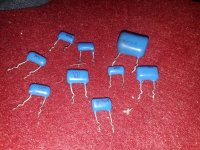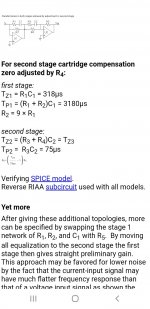I must say we live in 2022 not 1982 and most modern turntables have inbuilt phono preamp. I.e. without any cables. See here [ https://www.patreon.com/posts/protsentazh-86-71932355 ] my yesterday`s calculations: 86%.About 20-25pf in the arm . The signal cable of many Japanese turntables had a very small capacity - 60-70pf. I had several Japanese turntables - Sony, Hitachi, Pioneer, Kenwood , Onkio , and others - all of them had a cable with a small capacity
There's one argument I agree with at Paul McGowan: people like to have the choice of changing components , that is why active speakers didn't get to the heart of audiophiles...They want to use their favourite cart with their favourite preamp, then change it with another, then change the cart and its loading...
If you look into how manufacturers did their phono setup in the 80's you see a constant 100pF loading in most preamps and you wonder why...
Well.... they used to sell an entire line: turntable with one cart, one receiver or control preamplifier, then one amp and speakers, yet the line still allowed changing every component.
The turntable came with its own cart already attached on the tonearm and a carefully chosen stereo cable that would match the added capacitance to the 100pF inside the preamp so that the cart had the right loading recommended by the cart manufacturer.
If you wanted a different cart on your tonearm you only change the link cable between the turntable and phono preamp with the right capacitance.
If you want to promote a turntable with all set inside cart and preamp you're looking into "active speaker" market philosophy that never got to public heart. O still wait from B&W an active Nautilus, 802 or 804 🙂
Maybe the smartest people bought active
studio monitors, but I don't see many audiophiles doing it yet...
If you look into how manufacturers did their phono setup in the 80's you see a constant 100pF loading in most preamps and you wonder why...
Well.... they used to sell an entire line: turntable with one cart, one receiver or control preamplifier, then one amp and speakers, yet the line still allowed changing every component.
The turntable came with its own cart already attached on the tonearm and a carefully chosen stereo cable that would match the added capacitance to the 100pF inside the preamp so that the cart had the right loading recommended by the cart manufacturer.
If you wanted a different cart on your tonearm you only change the link cable between the turntable and phono preamp with the right capacitance.
If you want to promote a turntable with all set inside cart and preamp you're looking into "active speaker" market philosophy that never got to public heart. O still wait from B&W an active Nautilus, 802 or 804 🙂
Maybe the smartest people bought active
studio monitors, but I don't see many audiophiles doing it yet...
Last edited:
I agree with you that this is naked marketing. But we are not pigs but audiophiles and know slighly more than typical marketer 😉Well.... they used to sell an entire line: turntable with one cart, one receiver or control preamplifier, then one amp and speakers, yet the line still allowed changing every component.
The maketing always finds the best solutions because it affords that! We should be able to know slightly more solutions that hit the market too!
In 2022, a good phono stage is a standalone device in a beautiful case. Of course, the built-in version also has the right to exist. I plan to install several controls and indications on the front panel, it is impossible to do this for the built-in one.
And one more question - what do the statistics say about the power supply of the built-in phono stages? What voltages are usually available in a stock turntable power supply?my yesterday`s calculations: 86%.
My marketing @msg# 341 : objective study of statistics showed 86% inbuilt (incl. Audio Technica, Teac, Yamaha, Denon - are all they fools?), are you disagree?The maketing always finds the best solutions because it affords that!
Video about subj with multilanguage subtitles in English, German, French, Japanese, Danish, Greek, Polish, Swedish, Dutch, Turkish, Czech, Sanskrit
https://www.patreon.com/posts/phono-81-xxi-v-1-72067774
https://www.patreon.com/posts/phono-81-xxi-v-1-72067774
Last edited:
Starting from min 24 the translation switches to russian or ukrainian...I don't know the difference.
You might wanna try posting at swap meet commercial section.
You might wanna try posting at swap meet commercial section.
Yes, I see. Something is wrong with youtube autiomatic subtitle translator. I will ask youtube support.Starting from min 24 the translation switches to russian or ukrainian..
Personally , I find it very funny to look at these modern turntables with built - in phonopreamps . Most of them are cheap Chinese Hanpin . And I strongly suspect that neither Audio Technica , nor Denon , nor Onkyo actually have anything to do with the development of these turntables . They just paid the Chinese money ..... I use good vintage turntables ( and I like it ) . And phonopreamps in separate cases ( I have a lot of them ) .I must say we live in 2022 not 1982 and most modern turntables have inbuilt phono preamp. I.e. without any cables. See here [ https://www.patreon.com/posts/protsentazh-86-71932355 ] my yesterday`s calculations: 86%.
I contacted youtube support and they said they fixed it. Subtitles are now available in English, German, French, Swedish, Japanese, Hebrew, Greek, Turkish, Czech, Dutch -Starting from min 24 the translation switches to russian or ukrainian...
You might wanna try posting at swap meet commercial section.
Could you, please, help me with some piece of information? I have a lot of these caps from a multichannel recording mixer Elektronika pm-03.Could you tell me what dielectric is used in them or what european type would they be similar to? I destroyed one and saw it's film and foil construction and usually that's good.I have lots of filters in cassette players and phono preamps to work on and they look very appealing to me as I have them in serious quantities.
Attachments
Could you, please, help me with some piece of information? I have a lot of these caps from a multichannel recording mixer Elektronika pm-03.Could you tell me what dielectric is used in them or what european type would they be similar to? I destroyed one and saw it's film and foil construction and usually that's good.I have lots of filters in cassette players and phono preamps to work on and they look very appealing to me as I have them in serious quantities.
Metallized Polyester film capacitor K73-9
Thank you! I chequed it, it's film and foil not metalised through vapour deposition.Metallized Polyester film capacitor K73-9
Right...so tweeting that high frequency ringing pattern ( associated to a SNR that humans can't even hear on vinyl if on any source at all) is better than the linearity and just good enough SNR you get from Leoniv's type of circuit...That was discussed by others too:
http://waynestegall.com/audio/riaa.htm#mozTocId495677
The noise you get from an inverted input is also more uniformely distributed in the frequency range making the total SNR less dependent on frequency which is a plus at a subliminal level.
Bipolar transistor input current noise has simillar effect 😉
http://waynestegall.com/audio/riaa.htm#mozTocId495677
The noise you get from an inverted input is also more uniformely distributed in the frequency range making the total SNR less dependent on frequency which is a plus at a subliminal level.
Bipolar transistor input current noise has simillar effect 😉
Attachments
A little note is required regarding the results shown in this video. The comparison showed not the noise difference between two different amplifier topologies, but the noise difference between AD745 and LSK389. If you use the same components, both circuits will show approximately the same noise.the linearity and just good enough SNR you get from Leoniv's type of circuit...
- Home
- Vendor's Bazaar
- Nick Sukhov SU-XXI MM Phono stage -85 dBA SN ratio...


